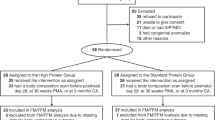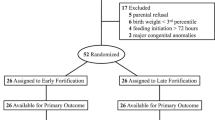Abstract
Objectives
The impact of exclusive human milk diet (EHMD) on postnatal growth remains controversial. This study aims to investigate the association between EHMD and short-term growth.
Methods
This multicenter retrospective study aims to compare growth between the EHMD and non-EHMD groups among infants <32 weeks of gestation. Primary outcomes include weight, length, and head circumference growth trajectories between birth and 34 weeks postmenstrual age. Sensitivity and subgroup analyses were performed.
Results
An EHMD was independently associated with poorer length growth, especially in infants born at ≥28 weeks’ gestation or those exposed to hypertensive disorders of pregnancy. While initiating fortification at <26 kcal/oz on an EHMD showed inferior growth, initiating fortification at ≥26 kcal/oz was associated with improved weight growth, and similar length and head circumference growth when compared to the non-EHMD group.
Conclusions
An EHMD with initial fortification at ≥26 kcal/oz may be implemented to avoid bovine milk exposure while sustaining comparable growth.
This is a preview of subscription content, access via your institution
Access options
Subscribe to this journal
Receive 12 print issues and online access
$259.00 per year
only $21.58 per issue
Buy this article
- Purchase on Springer Link
- Instant access to full article PDF
Prices may be subject to local taxes which are calculated during checkout


Similar content being viewed by others
Data availability
Deidentified individual participant data may be requested with a formal utilization plan, pending approval by the Institutional Review Board of Southern California Kaiser Permanente.
References
Parker MG, Stellwagen LM, Noble L, Kim JH, Poindexter BB, Puopolo KM et al. Promoting human milk and breastfeeding for the very low birth weight infant. Pediatrics. 2021;148. https://doi.org/10.1542/peds.2021-054272.
Sullivan S, Schanler RJ, Kim JH, Patel AL, Trawöger R, Kiechl-Kohlendorfer U, et al. An exclusively human milk-based diet is associated with a lower rate of necrotizing enterocolitis than a diet of human milk and bovine milk-based products. J Pediatr. 2010;156:562–7.e1.
Hair AB, Hawthorne KM, Chetta KE, Abrams SA. Human milk feeding supports adequate growth in infants ≤1250 grams birth weight. BMC Res Notes. 2013;6. https://doi.org/10.1186/1756-0500-6-459.
Cristofalo EA, Schanler RJ, Blanco CL, Sullivan S, Trawoeger R, Kiechl-Kohlendorfer U, et al. Randomized trial of exclusive human milk versus preterm formula diets in extremely premature infants. J Pediatr. 2013;163:1592–1595.e1.
Lucas A, Boscardin J, Abrams SA. Preterm infants fed cow’s milk-derived fortifier had adverse outcomes despite a base diet of only mother’s own milk. Breastfeed Med. 2020;15:297–303.
Hair AB, Peluso AM, Hawthorne KM, Perez J, Smith DP, Khan JY, et al. Beyond necrotizing enterocolitis prevention: improving outcomes with an exclusive human milk-based diet. Breastfeed Med. 2016;11:70–4.
O’Connor DL, Kiss A, Tomlinson C, Bando N, Bayliss A, Campbell DM, et al. Nutrient enrichment of human milk with human and bovine milk-based fortifiers for infants born weighing <1250 g: a randomized clinical trial. Am J Clin Nutr. 2018;108:108–16.
Jensen GB, Domellöf M, Ahlsson F, Elfvin A, Navér L, Abrahamsson T. Effect of human milk-based fortification in extremely preterm infants fed exclusively with breast milk: a randomised controlled trial. eClinicalMedicine. 2024;68:102375.
Huston RK, Markell AM, McCulley EA, Pathak M, Rogers SP, Sweeney SL, et al. Decreasing necrotizing enterocolitis and gastrointestinal bleeding in the neonatal intensive care unit. Infant Child Adolesc Nutr. 2014;6:86–93.
Colacci M, Murthy K, DeRegnier R-AO, Khan JY, Robinson DT. Growth and development in extremely low birth weight infants after the introduction of exclusive human milk feedings. Am J Perinatol. 2017;34:130–7.
Eibensteiner F, Auer-Hackenberg L, Jilma B, Thanhaeuser M, Wald M, Haiden N. Growth feeding tolerance and metabolism in extreme preterm infants under an exclusive human milk diet. Nutrients. 2019;11. https://doi.org/10.3390/nu11071443.
Velumula PK, Elbakoush F, Elfadeel H, Lulic-Botica M, Natarajan G, Bajaj M. Comparative growth outcomes in preterm infants fed either mother’s own milk or donor human milk. Breastfeed Med. 2023;18:300–6.
Patel AL, Engstrom JL, Meier PP, Kimura RE. Accuracy of methods for calculating postnatal growth velocity for extremely low birth weight infants. Pediatrics. 2005;116:1466–73.
Assad M, Elliott MJ, Abraham JH. Decreased cost and improved feeding tolerance in VLBW infants fed an exclusive human milk diet. J Perinatol. 2016;36:216–20.
Huston RK, Markell AM, McCulley EA, Gardiner SK, Sweeney SL. Improving growth for infants ≤1250 grams receiving an exclusive human milk diet. Nutr Clin Pract. 2018;33:671–8.
Bui KCT, Kim R, Abbasi A, Nguyen M, Villosis MF, Chen Q. Erythropoietin treatment is associated with a reduction in moderate to severe bronchopulmonary dysplasia in preterm infants. A regional retrospective study. Early Hum Dev. 2019;137:104831.
Bui KCT, Ellenhorn N, Abbasi A, Villosis MFB, Nguyen M, Truong H, et al. Erythropoietin is not a risk factor for severe retinopathy of prematurity among high risk preterm infants. Early Hum Dev. 2021;161:105440.
Chou F-S, Yeh H-W, Clark RH. A comparative study of postnatal anthropometric growth in very preterm infants and intrauterine growth. Nat Commun. 2023;14:5626.
Chou F-S, Yeh H-W, Clark RH. Postnatal weight growth trajectory in infants born between 30 4/7 weeks and 34 3/7 weeks of gestation. J Perinatol. 2024;44:575–7.
twang: toolkit for weighting and analysis of nonequivalent groups. Comprehensive R Archive Network (CRAN). https://cran.r-project.org/web/packages/twang/index.html. Accessed 31 May 2023.
Ripley BD. The R project in statistical computing. MSOR Connect. 2001;1:23–25.
Tests in linear mixed effects models [R package lmerTest version 3.1–3]. 2020. https://cran.r-project.org/web/packages/lmerTest/index.html. Accessed 6 Jan 2024.
Cormack BE, Embleton ND, van Goudoever JB, Hay WW Jr, Bloomfield FH. Comparing apples with apples: it is time for standardized reporting of neonatal nutrition and growth studies. Pediatr Res. 2016;79:810–20.
Ehrenkranz RA, Younes N, Lemons JA, Fanaroff AA, Donovan EF, Wright LL, et al. Longitudinal growth of hospitalized very low birth weight infants. Pediatrics. 1999;104:280–9.
Fenton TR, Kim JH. A systematic review and meta-analysis to revise the Fenton growth chart for preterm infants. BMC Pediatr. 2013;13:59.
Greenbury SF, Angelini ED, Ougham K, Battersby C, Gale C, Uthaya S, et al. Birthweight and patterns of postnatal weight gain in very and extremely preterm babies in England and Wales, 2008–19: a cohort study. Lancet Child Adolesc Health. 2021;5:719–28.
Fenton TR, Anderson D, Groh-Wargo S, Hoyos A, Ehrenkranz RA, Senterre T. An Attempt to Standardize the Calculation of Growth Velocity of Preterm Infants-Evaluation of Practical Bedside Methods. J Pediatr. 2018;196:77–83.
Acknowledgements
The authors would like to thank Dr. Hung-Wen Yeh, PhD of Children’s Mercy Research Institute in Kansas City, MO, USA for his statistical consultation.
Author information
Authors and Affiliations
Contributions
FC conceptualized and designed the study, supervised data collection, performed the initial analysis, interpreted data, and drafted the initial manuscript. JZ collected data, assisted in data analysis, and critically reviewed the manuscript. CN participated in study design, interpreted data, and critically reviewed the manuscript. GMF, LRT, MFBV, and KBD contributed to data interpretation and critically reviewed the manuscript for important intellectual content. GMF also provided language editing to the final manuscript. AL participated in study design, supervised data interpretation, and critically reviewed the manuscript.
Corresponding author
Ethics declarations
Competing interests
The authors declare no competing interests.
Ethics approval
This data-only study was approved by the Institutional Review Board of Southern California Kaiser Permanente, with an exemption from the requirement for informed consent.
Additional information
Publisher’s note Springer Nature remains neutral with regard to jurisdictional claims in published maps and institutional affiliations.
Supplementary information
Rights and permissions
Springer Nature or its licensor (e.g. a society or other partner) holds exclusive rights to this article under a publishing agreement with the author(s) or other rightsholder(s); author self-archiving of the accepted manuscript version of this article is solely governed by the terms of such publishing agreement and applicable law.
About this article
Cite this article
Chou, FS., Zhang, J., Nguyen, C. et al. The impact of exclusive human milk diet on short-term growth of very preterm infants. J Perinatol (2024). https://doi.org/10.1038/s41372-024-01980-w
Received:
Revised:
Accepted:
Published:
DOI: https://doi.org/10.1038/s41372-024-01980-w



